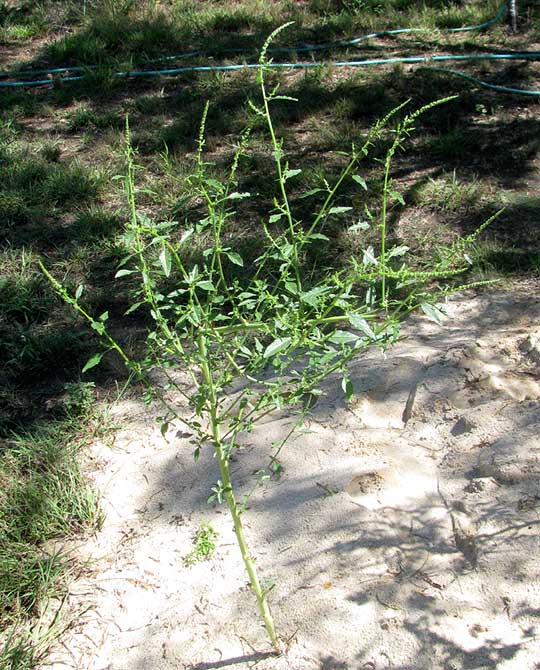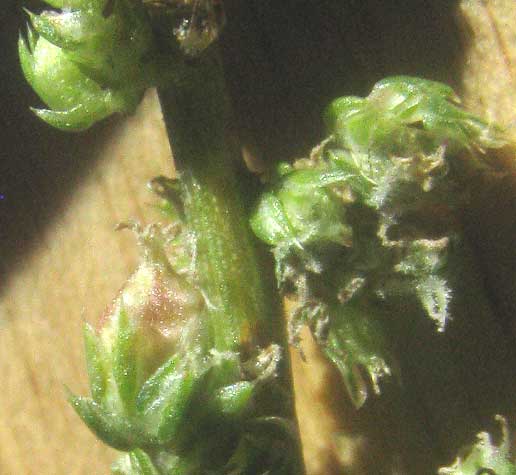Excerpts from Jim Conrad's
Naturalist Newsletter
from the September 29, 2013 Newsletter issued from the Frio Canyon Nature Education Center in the valley of the Dry Frio River in northern Uvalde County, southwestern Texas, on the southern border of the Edwards Plateau; elevation ~1750m (~5750 ft); N29.62°, W99.86°; USA
SAND AMARANTH
Last week we looked at a Sand Sunflower whose seeds had been introduced in a truckload of sand dumped in the backyard of the red cabin in the valley where I spent the winter. Next to that pretty sunflower grew yet a second species I've not seen elsewhere in the valley, but this waist-high plant was about as scraggly, colorless and weedy looking as you can imagine. That's it below:

Up close you find that the tiny flowers arranged in spikelike inflorescences at branch tips are unisexual, and that male and female flowers occur on separate plants. Male flowers consisting of only five stamens with bright yellow anthers and five sharply pointed tepals -- which are undifferentiated petals and sepals -- are shown below:

A clutter of female flowers with their white, fuzzy stigmas exposed, and a tiny oval fruit only 1/16th inch or 1.5mm high (at the picture's lower, left), are shown below:

Such very small, unisexual flowers without colorful corollas are typical of the Amaranth Family, the Amaranthaceae. And within that family, at least if you're in North America, if you have a herbaceous plant displaying only one leaf per stem node (alternate arrangement) and the flowers are unisexual -- all as seen with our sandpile plant -- you know you have a genuine amaranth, a species in the genus Amaranthus. However, about 70 amaranth species are recognized, with some 38 occurring in North America, so to know exactly what you have you must "do the botany."
It turns out that our sandpile amaranth is a fairly distinctive species and easy to key out in the online Flora of North America at http://www.efloras.org/florataxon.aspx?flora_id=1&taxon_id=101257.
Its main field marks are its spinelessness, its unisexual flowers on separate plants (plants dioecious), female flowers with five tepals only about 1.5 mm long, and the utricle-type fruit similarly small, only about 1.5 mm tall.
Very appropriately accompanying our Sand Sunflower on our sandpile, this is the Sand Amaranth, AMARANTHUS ARENICOLA, the species name arenicola meaning "growing on sand."
Sand Amaranth is native to the central and southwestern Great Plains, from Texas to Nebraska and South Dakota, and occasionally is introduced into other parts of North America and Europe.
Several amaranth species produce shiny, hard, small seeds that in various cultures have been popped like popcorn or ground into amaranth flour for breads, and some amaranth species provide leaves that can be cooked as a potherb. However, Sand Amaranth's seeds are exceptionally small, only about 1/32nd-inch across (1mm) so collecting them would be very tedious work, and the plants' leaves are narrow and small. However, seed-eating songbirds would find the black, shiny seeds about perfect to peck at.